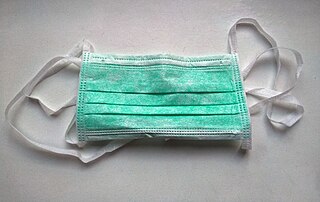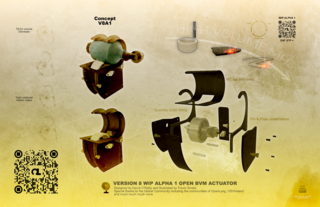
Personal protective equipment (PPE) is protective clothing, helmets, goggles, or other garments or equipment designed to protect the wearer's body from injury or infection. The hazards addressed by protective equipment include physical, electrical, heat, chemicals, biohazards, and airborne particulate matter. Protective equipment may be worn for job-related occupational safety and health purposes, as well as for sports and other recreational activities. "Protective clothing" is applied to traditional categories of clothing, and "protective gear" applies to items such as pads, guards, shields, or masks, and others. PPE suits can be similar in appearance to a cleanroom suit.

A ventilator is a machine that provides mechanical ventilation by moving breathable air into and out of the lungs, to deliver breaths to a patient who is physically unable to breathe, or breathing insufficiently. Modern ventilators are computerized microprocessor-controlled machines, but patients can also be ventilated with a simple, hand-operated bag valve mask. Ventilators are chiefly used in intensive-care medicine, home care, and emergency medicine and in anesthesiology.

A surgical mask, also known as a procedure mask, medical mask or simply as a face mask, is intended to be worn by health professionals during procedures in surgery and nursing. It is designed to prevent infections in patients and treating personnel by catching bacteria shed in liquid droplets and aerosols from the wearer's mouth and nose. They are not designed to protect the wearer from inhaling airborne bacteria or viruses whose particles are smaller, and they are less effective than respirators, such as N95 or FFP masks, which provide better protection due to their material, shape and tight seal.
The Strategic National Stockpile (SNS), originally called the National Pharmaceutical Stockpile (NPS), is the United States' national repository of antibiotics, vaccines, chemical antidotes, antitoxins, and other critical medical supplies.

The SEIU United Healthcare Workers West is a statewide local union of the Service Employees International Union in California in the United States. In 2020, it had 97,000 members, down from nearly 150,000 in 2013.

The COVID-19 pandemic has had far-reaching consequences beyond the spread of the disease itself and efforts to quarantine it. As the SARS-CoV-2 virus has spread around the globe, concerns have shifted from supply-side manufacturing issues to decreased business in the services sector. The pandemic caused the largest global recession in history, with more than a third of the global population at the time being placed on lockdown.

The COVID-19 pandemic spread to the United States in January 2020. It is a novel infectious disease caused by severe acute respiratory syndrome coronavirus 2. Local transmission had started by January, and deaths had occurred by February. By the end of March, cases had occurred in all 50 U.S. states, the District of Columbia, and all inhabited U.S. territories except American Samoa. As of May 4, 2020, the U.S. has the most confirmed active cases and deaths in the world; and its death rate was 206 per million people, the tenth-highest rate globally.

An N95 mask or N95 respirator is a particulate-filtering facepiece respirator that meets the U.S. National Institute for Occupational Safety and Health (NIOSH) N95 classification of air filtration, meaning that it filters at least 95% of airborne particles. This standard does not require that the respirator be resistant to oil; another standard, P95, adds that requirement. The N95 type is the most common particulate-filtering facepiece respirator. It is an example of a mechanical filter respirator, which provides protection against particulates but not against gases or vapors.

The ongoing COVID-19 pandemic spread to Germany on 27 January 2020, when the first case was confirmed and contained near Munich, Bavaria. The majority of the cases in January and early February originated from the headquarters of a vehicle-parts manufacturer there. On 25 and 26 February, multiple cases related to the Italian outbreak were detected in Baden-Württemberg. A large cluster linked to a carnival event was formed in Heinsberg, North Rhine-Westphalia, with the first death reported on 9 March 2020. New clusters were introduced in other regions via Heinsberg as well as via people arriving from China, Iran and Italy, from where non-Germans could arrive by plane until 17–18 March.

Flattening the curve is a public health strategy introduced during the COVID-19 pandemic. The curve being flattened is the epidemic curve, a visual representation of the number of infected people needing health care over time. During an epidemic, a health care system can break down when the number of people infected exceeds the capability of the health care system to take care of them. Flattening the curve means slowing the spread of the epidemic so that the peak number of people requiring care at a time is reduced, and the health care system is not overwhelmed. Flattening the curve relies on mitigation techniques such as social distancing.
This article documents the timeline of the COVID-19 pandemic in Pakistan.
The COVID-19 pandemic was confirmed to have reached Sabah, Malaysia, in March 2020.
Medical materials and other goods shortages caused by the COVID-19 pandemic quickly became a major issue of the pandemic. The matter of pandemic-related shortage has been studied in the past and has been documented in recent events. On the medical side, shortages of personal protective equipment such as medical masks, gloves, face shields, gear, sanitising products, are also joined by potential shortage of more advanced devices such as hospital beds, ICU beds, oxygen therapy, ventilators and ECMO devices. Human resources, especially in terms of medical staff, may be drained by the overwhelming extent of the epidemic and associated workload, together with losses by contamination, isolation, sickness or mortality among health care workers. Territories are differently equipped to face the pandemic. Various emergency measures have been taken to ramp up equipment levels such as purchases, while calls for donations, local 3D makers, volunteer staffing, mandatory draft, or seizure of stocks and factory lines have also occurred. Bidding wars between different countries and states over these items are reported to be a major issue, with price increases, orders seized by local government, or cancelled by selling company to be redirected to higher bidder. In some cases, medical workers have been ordered to not speak about these shortages of resources.

An open-source ventilator is a disaster-situation ventilator made using a freely licensed (open-source) design, and ideally, freely available components and parts. Designs, components, and parts may be anywhere from completely reverse-engineered or completely new creations, components may be adaptations of various inexpensive existing products, and special hard-to-find and/or expensive parts may be 3D-printed instead of purchased. As of early 2020, the levels of documentation and testing of open-source ventilators was well below scientific and medical-grade standards.

This article documents the chronology of the response to the COVID-19 pandemic in April 2020, which originated in Wuhan, China in December 2019. Some developments may become known or fully understood only in retrospect. Reporting on this pandemic began in December 2019.
Pandemic predictions and preparations prior to COVID-19 were pandemic predictions made and preparations carried out in the early twenty-first century prior to the 2019–20 COVID-19 pandemic. The World Health Organization (WHO) and the World Bank warned about the risk of pandemics throughout the 2000s and the 2010s, especially after the 2002–2004 SARS outbreak with the Global Preparedness Monitoring Board releasing its first report in late 2019. The WHO coined the term, Disease X in 2018 so the preparations for the next, at-the-time unknown pandemic could be undertaken. In 2005–2006, prior to the 2009 swine flu pandemic and during the decade following the pandemic, the governments in the United States and France prepared stocks of pandemic equipment and depleted their stocks.
Megan L. Ranney is an American emergency physician who works at the Rhode Island Hospital and is an Associate Professor at Brown University. During the 2019–20 coronavirus pandemic Ranney brought public attention to the deficit of protective equipment for United States frontline workers. She launched the grassroots organisation #GetUsPPE to collect, create and distribute personal protective equipment around the United States.

The wearing of face masks during the COVID-19 pandemic has received varying recommendations from different public health agencies and governments. The topic has been a subject of debate, with various public health agencies and governments disagreeing on a protocol for wearing face masks. As of early May, 88% of the world's population lives in countries that recommend or mandate the usage of masks in public and 75+ countries have mandated the use of masks. Debates have emerged regarding whether masks should be worn even when social distancing at six feet, whether they should be worn during exercise, worn in the home to reduce viral load, and whether there are mitigating factors. Additionally, public health agencies of different countries and territories have often changed their recommendations regarding face masks over time. Face masks have been a subject of shortages, and also been made compulsory in some countries.

Medical gowns are hospital gowns worn by medical professionals as personal protective equipment (PPE) in order to provide a barrier between patient and professional. Whereas patient gowns are flimsy often with exposed backs and arms, PPE gowns as seen below in the cardiac surgeon photograph cover most of the exposed skin surfaces of the professional medics.
Greg Burel is the former director (2010-2020) of the United States Strategic National Stockpile, which proved to be a critical component of the U.S. federal response to the 2019-2020 coronavirus pandemic.










